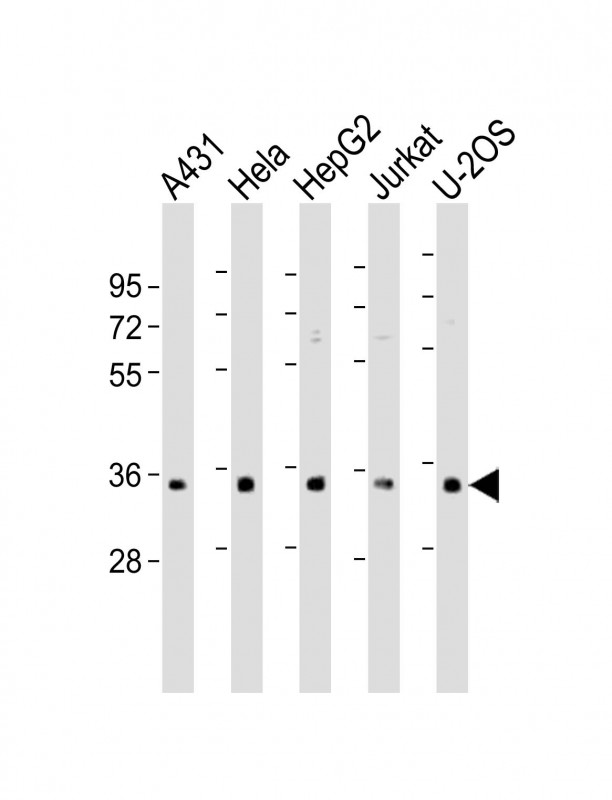
| WB | 1/500-1/1000 | Human,Mouse,Rat |
| IF | 咨询技术 | Human,Mouse,Rat |
| IHC | 咨询技术 | Human,Mouse,Rat |
| ICC | 技术咨询 | Human,Mouse,Rat |
| FCM | 咨询技术 | Human,Mouse,Rat |
| Elisa | 咨询技术 | Human,Mouse,Rat |
| Aliases | RNA-binding protein with serine-rich domain 1, SR-related protein LDC2, RNPS1, LDC2 |
| Entrez GeneID | 10921 |
| WB Predicted band size | 34.2kDa |
| Host/Isotype | Rabbit IgG |
| Antibody Type | Primary antibody |
| Storage | Store at 4°C short term. Aliquot and store at -20°C long term. Avoid freeze/thaw cycles. |
| Species Reactivity | Human, Mouse, Rat |
| Immunogen | This RNPS1 antibody is generated from a rabbit immunized with a KLH conjugated synthetic peptide between 11-44 amino acids from the RNPS1. |
+ +
以下是关于RNPS1 (N-Term)抗体的3篇参考文献,按文献名称、作者和摘要内容简要概括:
1. **"RNPS1. a novel RNA-binding protein involved in DNA damage response and alternative splicing regulation"**
*作者:Sakashita et al. (2004)*
*摘要*:研究通过RNPS1 (N-Term)抗体进行免疫沉淀和Western blot分析,发现RNPS1在DNA损伤修复中与SR蛋白相互作用,并参与调控mRNA剪接。
2. **"The RNA-binding protein RNPS1 promotes apoptosis and suppresses tumorigenesis in colorectal cancer"**
*作者:Li et al. (2018)*
*摘要*:使用RNPS1 N端特异性抗体检测其在结直肠癌组织中的表达,发现RNPS1通过调控促凋亡基因的剪接抑制肿瘤生长,并与临床预后相关。
3. **"A role for RNPS1 in nonsense-mediated mRNA decay and genome stability"**
*作者:Kashima et al. (2006)*
*摘要*:通过RNPS1 (N-Term)抗体的免疫荧光实验,证明RNPS1定位于细胞核内,参与无义介导的mRNA降解(NMD)过程,并维持基因组稳定性。
4. **"Proteomic analysis of the human spliceosome identifies RNPS1 as a component of the exon junction complex"**
*作者:Lejeune et al. (2002)*
*摘要*:利用RNPS1 N端抗体进行蛋白质互作研究,证实RNPS1是外显子连接复合体(EJC)的核心组分,在mRNA剪接和翻译监控中起关键作用。
以上文献均通过RNPS1 (N-Term)抗体探索了该蛋白在RNA代谢、癌症及DNA修复中的功能。
The RNPS1 (N-Term) antibody targets the N-terminal region of the RNA-binding protein RNPS1 (RNA-binding protein with serine-rich domain 1), a key component of the exon junction complex (EJC). RNPS1 plays critical roles in post-transcriptional RNA processing, including pre-mRNA splicing, nonsense-mediated mRNA decay (NMD), and mRNA surveillance. It is recruited to spliced mRNAs during EJC assembly, where it facilitates interactions between splicing machinery and downstream mRNA quality control pathways. Dysregulation of RNPS1 has been implicated in cancer progression and neurological disorders due to its impact on alternative splicing and gene expression.
The RNPS1 (N-Term) antibody is commonly used to detect endogenous RNPS1 protein in applications such as Western blotting, immunoprecipitation, and immunofluorescence. It is often raised in rabbits or mice, with specificity validated through knockout controls or siRNA-mediated depletion. Researchers utilize this antibody to study RNPS1’s involvement in splicing regulation, its association with EJC components (e.g., Magoh, Y14), and its role in cellular stress responses. Commercial variants may differ in clonality (monoclonal/polyclonal) and conjugation (e.g., HRP, fluorescent tags). Proper validation in specific experimental systems is essential due to potential cross-reactivity with structurally related proteins.
×